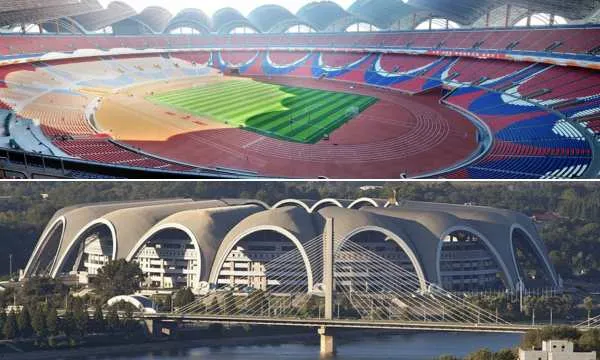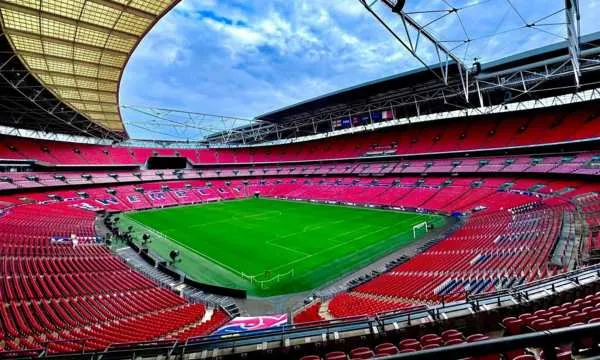Ready to explore the largest football stadiums and feel their energy right now?
Anúncios
Around the globe, colossal venues welcome fans who share a passion for the beautiful game.
As you explore, you will find surprising facts about capacities, architecture, and unforgettable nights.
Moreover, you will discover how these football stadiums shape memories for generations of supporters.
By the end, you will know which football stadiums stand tallest and why they matter so much to the sport.
Rungrado May Day Stadium (North Korea)
In Pyongyang stands the Rungrado May Day Stadium, widely cited with a capacity near 114,000, making it one of the largest venues ever designed for football and large ceremonies.
Opened in 1989 and shaped like a magnolia blossom, it features an expansive field and multiuse track, with a roof of interlaced arches that creates a striking skyline presence.
Its sheer scale and ceremonial versatility have made it a symbol of mass events and sporting spectacle.
-
Approximate capacity reported at around 114,000 seats in football stadiums rankings
-
Host to mass gymnastics and artistic performances including the Arirang Festival
-
Occasional international football friendlies and athletics events
-
Distinctive sixteen petal roof design with sweeping sightlines
-
Renovated in the 2010s to refresh facilities and seating
While detailed international fixtures are limited, the venue remains a point of curiosity for global fans who track record capacities and crowd choreographies.
In short, Rungrado May Day is often referenced in discussions about the absolute upper limit of football stadiums size.

Camp Nou (Spain)
Camp Nou in Barcelona is a landmark for world football, historically hosting over 99,000 fans and currently undergoing a comprehensive modernization known as the Espai Barça project.
The redesign aims to enhance comfort, accessibility, and sustainability, with future plans indicating an expanded capacity exceeding 100,000 once fully completed.
Generations of supporters remember European finals, El Clásico epics, and the artistry of club legends on this stage.
-
Historic capacity around 99,354 before renovation at one of Europe’s great football stadiums
-
Renovation targets a capacity of roughly 105,000 with advanced amenities
-
Hosted UEFA Champions League finals and countless La Liga classics
-
Museum and tour rank among the most visited in sports
-
Modern upgrades to transport links and fan services
When the project fully reopens, the venue will welcome a new era of matchday experience for Barcelona supporters and visitors alike.
In the meantime, its legacy as a cathedral of football remains unshaken among global football stadiums.
FNB Stadium (Soccer City) (South Africa)
Located in Johannesburg, FNB Stadium is South Africa’s flagship football arena with a capacity near 94,736 and an exterior inspired by traditional African pottery.
It served as the centerpiece of the 2010 FIFA World Cup, including the opening match and the final, becoming an emblem of continental pride.
The bowl design delivers excellent acoustics and sweeping views from nearly every seat.
-
Hosted the 2010 FIFA World Cup final between Spain and the Netherlands
-
Serves as a frequent venue for major derbies and national team fixtures
-
Modern concourses, hospitality areas, and media facilities
-
Iconic calabash facade illuminated at night
-
Versatile for concerts and large civic events at one of Africa’s leading football stadiums
Beyond football, the stadium unites communities through music and cultural gatherings throughout the year.
Consequently, its reputation stretches far beyond sport alone and adds depth to the story of football stadiums.
Rose Bowl Stadium (United States)
The Rose Bowl in Pasadena is world famous for American football traditions, yet it also holds a significant place in global soccer history with a seating capacity surpassing 88,000 for major events.
It hosted the 1994 FIFA World Cup final and the 1999 FIFA Women’s World Cup final, two landmark moments that expanded the sport’s audience in the United States.
Its vast terraces and classic bowl form deliver a unique big match atmosphere.
-
Hosted Brazil versus Italy in the 1994 FIFA World Cup final
-
Hosted the 1999 Women’s World Cup final won by the United States
-
Site of high profile international friendlies and club tours
-
Picturesque mountain backdrop and historic status
-
Adaptable configuration for football and concerts in one of the most storied football stadiums
Today, it remains a sought after venue for showcase soccer matches that draw diverse crowds and global attention.
Therefore, the Rose Bowl continues to bridge American sporting heritage with the world’s game and the broader culture of football stadiums.
Wembley Stadium (England)
Wembley in London is synonymous with national finals and international showpieces, offering around 90,000 seats in a modern arena crowned by its soaring arch.
Reopened in 2007, it integrates premium hospitality, excellent transport access, and advanced pitch technology to support a busy calendar.
From domestic cup finals to UEFA showcases, Wembley is a centerpiece of European football.
-
Approximate capacity of 90,000 with an iconic 133 meter arch
-
Host to FA Cup and EFL Cup finals and England national team matches
-
Venue for UEFA EURO finals and Champions League finals
-
Comprehensive accessibility and family friendly facilities
-
Surrounding district offers dining, retail, and fan zones that celebrate football stadiums culture
With a schedule that blends club, country, and entertainment, Wembley sets a benchmark for versatility and fan experience.
In essence, it remains a must visit for supporters traveling to the United Kingdom and exploring great football stadiums.

Lusail Stadium (Qatar)
Opened for the 2022 FIFA World Cup near Doha, Lusail Stadium seats approximately 88,966 and hosted the tournament’s final between Argentina and France.
Its shimmering exterior references traditional lanterns, while the interior prioritizes cooling, comfort, and efficient circulation.
The stadium showcased advanced event delivery during one of the sport’s most watched finals.
-
Hosted the 2022 FIFA World Cup final featuring Argentina and France
-
Designed with advanced climate management for spectator comfort
-
Integrated public transport links for smoother arrivals and departures
-
Flexible legacy plan for ongoing community and event uses
-
Premium seating tiers and hospitality lounges in a flagship of modern football stadiums
As a recent build, it continues to anchor major football events and special occasions in the region.
Accordingly, its legacy will be measured by how well it serves fans long after the tournament as part of the new era of football stadiums.
Azteca Stadium (Mexico)
Estadio Azteca in Mexico City is a temple of the sport with a capacity typically listed above 87,000 and a history that includes Pelé and Diego Maradona at their peak.
It is the only venue to host two men’s FIFA World Cup finals, in 1970 and 1986, cementing its unparalleled status in football folklore.
From the Game of the Century to unforgettable club clashes, Azteca’s stories are woven into global memory.
-
Hosted 1970 and 1986 FIFA World Cup finals among the most famous in football stadiums history
-
Venue for regional finals and high stakes derbies
-
Panoramic tiers and intense acoustics
-
Ongoing modernization to improve amenities and access
-
Visited by many of the sport’s greatest players
As renovations continue, the stadium aims to enrich the spectator experience while preserving its mystique.
In conclusion, Azteca remains a bucket list destination for fans who love historic football stadiums.
Conclusion
From Pyongyang to Mexico City, the largest football stadiums offer more than capacity figures, they offer shared experiences that define eras.
Each arena blends history, architecture, and atmosphere into moments that fans cherish for life.
As new projects rise and classic venues evolve, the global stage for the beautiful game keeps expanding with comfort, safety, and inclusivity in mind across the world’s leading football stadiums.
If you enjoyed this guide, keep exploring our articles to compare designs, matchday vibes, and travel tips for your next football journey.
FAQs
1. Besides capacity, what are the main trends in the construction of new football stadiums?
Focus on fan experience through technology (5G Wi-Fi, 360° screens), sustainability (renewable energy), and multifunctionality for economic viability.
2. What, besides capacity, contributes to a stadium’s atmosphere being considered “legendary”?
The design’s acoustics, proximity to the pitch, the passion of the fans, and the history of games and idols that have graced the venue.
3. Is it possible to visit these stadiums on non-match days?
Yes, most offer guided tours that provide access to restricted areas such as locker rooms, museums, and the players’ tunnel, offering an immersive experience.
4. What type of technology is used on the pitches of modern stadiums?
The use of hybrid grass (a mix of natural and synthetic turf) and underground systems for drainage, irrigation, and heating to maintain field quality.
5. What usually happens to stadiums built for major events like the World Cup?
The best plans convert them for community use or reduce their capacity. Without proper planning, they risk becoming costly and underused.


